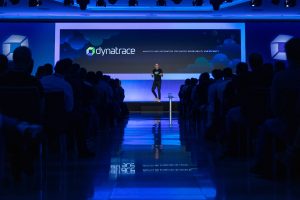Dynatrace has been ranked No. #1 for the IT Operations Use Case (4.15/5) in Gartner’s “’Critical Capabilities for Application Performance Monitoring and Observability’”
Artificial intelligence (AI) and IT automation are rapidly changing the landscape of IT operations.
AI can help automate tasks, improve efficiency, and identify potential problems before they occur. IT automation can help to not only improve the overall quality of IT services but also to reduce associated costs. In the recently published Gartner® “Critical Capabilities for Application Performance Monitoring and Observability,” Dynatrace scored highest for the IT Operations Use Case (4.15/5) in the Gartner report.
Data, AI, analytics, and automation are key enablers for efficient IT operations
Data is the foundation for AI and IT automation. IT organizations have access to massive volumes of data to troubleshoot, optimize, and secure application environments.
But teams encounter challenges when they need to quickly find answers and act. Teams get bogged down manually tagging data, reacting to alert storms, switching between disconnected dashboards, tediously trying to restore and correlate observability data from an archive, or interpreting incomplete data because of sampling or lack of retention.
As a result, IT teams spend far too much time chasing problems, which keeps them from working on high-priority assignments. When data is stored and managed in Dynatrace Grail, a data lakehouse, teams get real-time and precise answers powered by Davis AI for decision making and automating workflows.
How IT operations teams can de-silo monitoring data
According to the Gartner report, “IT operations practitioners may be in specific silos, such as the network team, server team, virtualization team, application support team or other cross-functional teams (such as a generalized monitoring team). Most use of APM [application performance monitoring] and observability tools in traditional IT operations teams involves generalists tasked with identifying problems quickly. This is accomplished by using service monitoring and anomaly detection for early-warning notifications of performance issues.”
Dynatrace was ranked No. 1 for IT Operations Use Case with a score of 4.15 out of 5.00.
From the Dynatrace perspective, IT operations practitioners can eliminate monitoring silos and benefit from Dynatrace, which unifies all monitoring data and provides seamless access to answers, insights, and IT automation powered by Grail, Davis, and AutomationEngine.
Grail stores and unifies all observability, security, and business data
Now organizations can store all their observability, security, and business data in one repository: Grail, in Dynatrace without having to manage schemas, indexes, or storage tiers. The data is stored with full context, which enables AI to deliver precise answers with speed and analytics to give rich insights with efficiency. The benefit of unifying all observability data is that teams can break the silos and seamlessly access answers and insights with the power of AI and advanced analytics. They can pinpoint exact root cause with causal AI, track service-level objectives (SLOs), and identify critical risks.
Hypermodal AI and AI-powered analytics provides precise answers and actionable insights
Dynatrace uses “hypermodal” AI, or Davis, built into its core, which is constantly working to solve problems that are far too complex for traditional machine learning and AI.
Moreover, Davis Predictive AI provides predictions about future outcomes and causal AI connects the dots and provides automated root-cause analysis.
When these AI techniques work synergistically, the benefits are far greater from what either technique could deliver. When teams want to dive deeper to answer ad hoc questions, teams can contextually analyze massive datasets in Grail with near-instant results in Dynatrace Notebooks, thanks to the easy-to-learn Dynatrace Query Language (DQL) and massively parallel processing (MPP).
Intelligent IT automation
Key to intelligent IT automation is the ability to generate accurate answers.
Accurate answers pave the way for IT automation, which helps reduce costs by automating tasks that a human would otherwise perform. This frees teams to focus on more strategic tasks. IT automation also helps improve operational efficiency by automating repetitive tasks. For example, connecting the right teams and equipping them with answers in real time, automatically remediating problems and vulnerabilities, and auto-scaling and resizing load distributions. Furthermore, custom apps powered by AppEngine make it possible for any team to create purpose-built solutions leveraging observability, security, and business data.
Want to learn more?
Check out “2023 Gartner Magic Quadrant™ for APM and Observability” and the “2023 Gartner Critical Capabilities for APM and Observability” report for more details and start a free trial to check out the Dynatrace experience yourself.
Gartner, Critical Capabilities for Application Performance Monitoring and Observability, Mrudula Bangera, Padraig Byrne, Matt Crossley, Gregg Siegfried, 10 July 2023.
Gartner, Magic Quadrant for Application Performance Monitoring and Observability, Gregg Siegfried, Mrudula Bangera, Matt Crossley, Padraig Byrne, 5 July 2023.
GARTNER is a registered trademark and service mark of Gartner, Inc. and/or its affiliates in the U.S. and internationally, and MAGIC QUADRANT is a registered trademark of Gartner, Inc. and/or its affiliates and are used herein with permission. All rights reserved.
Gartner does not endorse any vendor, product or service depicted in its research publications, and does not advise technology users to select only those vendors with the highest ratings or other designation. Gartner research publications consist of the opinions of Gartner’s research organization and should not be construed as statements of fact. Gartner disclaims all warranties, expressed or implied, with respect to this research, including any warranties of merchantability or fitness for a particular purpose.





Looking for answers?
Start a new discussion or ask for help in our Q&A forum.
Go to forum